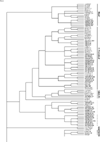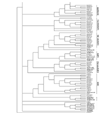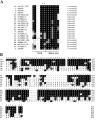Kinesins in the Arabidopsis genome: a comparative analysis among eukaryotes
- PMID: 11472632
- PMCID: PMC35278
- DOI: 10.1186/1471-2164-2-2
Kinesins in the Arabidopsis genome: a comparative analysis among eukaryotes
Abstract
Background: Kinesins constitute a superfamily of microtubule motor proteins that are found in eukaryotic organisms. Members of the kinesin superfamily perform many diverse cellular functions such as transport of vesicles and organelles, spindle formation and elongation, chromosome segregation, microtubule dynamics and morphogenesis. Only a few kinesins have been characterized in plants including Arabidopsis thaliana. Because of the diverse cellular functions in which kinesins are involved, the number, types and characteristics of kinesins present in the Arabidopsis genome would provide valuable information for many researchers.
Results: Here we have analyzed the recently completed Arabidopsis genome sequence and identified sixty-one kinesin genes in the Arabidopsis genome. Among the five completed eukaryotic genomes the Arabidopsis genome has the highest percentage of kinesin genes. Further analyses of the kinesin gene products have resulted in identification of several interesting domains in Arabidopsis kinesins that provide clues in understanding their functions. A phylogenetic analysis of all Arabidopsis kinesin motor domain sequences with 113 motor domain sequences from other organisms has revealed that Arabidopsis has seven of the nine recognized subfamilies of kinesins whereas some kinesins do not fall into any known family.
Conclusion: There are groups of Arabidopsis kinesins that are not present in yeast, Caenorhabditis elegans and Drosophila melanogaster that may, therefore, represent new subfamilies specific to plants. The domains present in different kinesins may provide clues about their functions in cellular processes. The comparative analysis presented here provides a framework for future functional studies with Arabidopsis kinesins.
Figures






References
-
- Goffeau A, Barrell BG, Bussey H, Davis RW, Dujon B, Feldmann H, Galibert F, et al. Life with 6000 genes. Science. 1996;274:563–567. - PubMed
-
- TCeS Consortium. Genome sequence of the nematode C. elegans: a platform for investigating biology. The C. elegans Sequencing Consortium. Science. 1998;282:2012–2018. - PubMed
-
- Adams MD, Celniker SE, Holt RA, Evans CA, Gocayne JD, Amanatides PG, Scherer SE, et al. The genome sequence of Drosophila melanogaster. Science. 2000;287:2185–2195. - PubMed
-
- TAG Initiative. Analysis of the genome sequence of the flowering plant Arabidopsis thaliana. Nature. 2000;408:796–815. - PubMed
-
- Hunter T, Plowman GD. The protein kinases of budding yeast: six score and more. Trends Biochem Sci. 1997;22:18–22. - PubMed
LinkOut - more resources
Full Text Sources
Molecular Biology Databases

